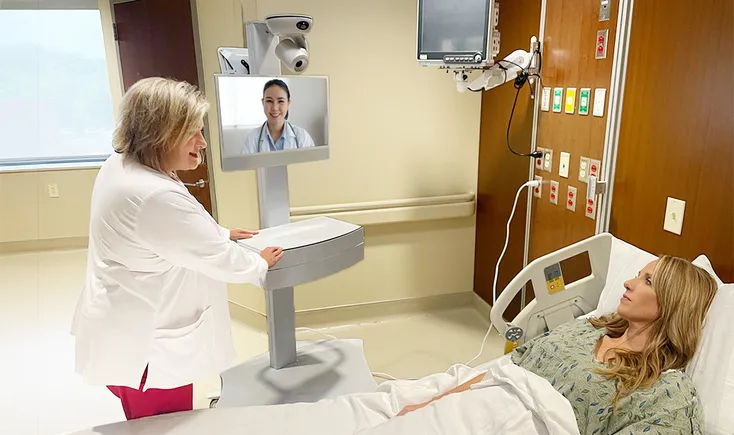In today’s healthcare environment, hospitals large and small are steadily shifting their focus from serving as a primarily inpatient site of care to investing in robust outpatient capabilities and reducing inpatient lengths of stay whenever possible. This shift is driven, in part, by the need to maximize value-based payments, streamline costs, and deliver care in the least intensive setting possible.
As a result, patients who do require inpatient care are more likely to have highly complex and acute needs — where rapid access to specialized care such as emergent stroke care or psychiatric care is even more critical.
Recent analysis from the American Hospital Association reports an increase in inpatient acuity of 3 percent from 2019 to 2024 and forecasts additional increases in inpatient acuity over the next decade, with a corresponding 3 percent increase in inpatient utilization and 9 percent increase in inpatient days.
The primary driver of increasing acuity and length-of-stay is chronic disease requiring complex care and tertiary services. Additionally, the incidence of chronic disease is only growing. A near doubling of the number of Americans over age 50 with at least one chronic disease by 2050 is predicted, as is a more than 91 percent increase in the number of older Americans with more than one chronic disease. Hospitals that don’t adapt to the rapidly changing patient mix will be left behind, and the financial difficulties that result will only worsen.
In this landscape, acute multi-specialty telemedicine is rapidly advancing as a strategic solution for hospitals. Through an integrated specialty telemedicine service, specialists from neurology and psychiatry to cardiology and infectious disease can be available when and where they are needed for high-quality, coordinated inpatient care in real time.
Bringing specialists together under a single, intuitive telemedicine platform providing on-demand consultation and collaborative care without adding extra strain to onsite teams is hospitals’ competitive edge. This real-time synergy allows hospitals to respond quickly to complex cases and complications, ensuring that life-saving interventions are available at the bedside when they are needed most.
Hospitals, for the foreseeable future, will have to manage the tension between caring for an increasingly acute and complex inpatient population with the ever-present need to reduce length-of-stay. Eighty-four percent of health system respondents in a recent McKinsey survey said length-of-stay optimization is a continued area of priority focus, and 41 percent identified length-of-stay as the performance area with the greatest potential for untapped margin improvement. On-demand availability through telemedicine is the key to balancing this tension, with three distinct qualities.
- Eliminates having to wait for a specialist to admit, treat, manage, and discharge a patient.
- Mitigates the need to board patients in the ED who are awaiting transfer to another facility that does have the specialist required for their condition.
- Brings many specialists together for patient care, bypassing the need for costly locums coverage or even costlier recruitment and retention of physicians in multiple specialties.
Real-world examples to illustrate the point:
- One hospital that Access TeleCare worked with reduced its length-of-stay for behavioral health patients by nearly 12 hours, on average, by deploying virtual behavioral health in its emergency department and virtual Consultation-Liaison Psychiatry in its med-surg units and ICU. The virtual behavioral health program helped them avoid $1.7 million in annualized boarding costs.
- Another hospital reduced its overall length-of-stay by 10 percent with a teleInfectious disease program and saw an immediate 25% increase in infectious disease revenue in the first year.
Additionally, there is a very real patient impact of minimizing length of stay where medically appropriate. With telemedicine, one hospital reduced a patient’s anticipated length of stay of weeks to several days, significantly enhancing his quality of life, because it had access to consultation through telemedicine with an infectious disease specialist who was able to accurately diagnose and optimize antibiotic treatment. Still another was spared a weeks-long course of multiple drugs for suspected tuberculosis when infectious disease consultation via telemedicine correctly diagnosed the patient with an autoimmune condition and coordinated care with a local specialist in rheumatology for the newly identified condition.
As the inpatient population becomes increasingly acute, and healthcare systems continue to focus on length-of-stay optimization strategies, acute specialty telemedicine’s value will only increase. Hospitals need a reliable multi-specialty partner that optimizes physician availability, prioritizes coordination and collaboration among virtual and in-person specialists and on-site teams, and shares ownership for quality and patient safety improvement.
With an acute specialty telemedicine partner, hospitals can drive significant financial improvements by caring for more of their acutely ill and complex patients – providing the right specialist(s), at the right time, no matter how complex the clinical scenario.








